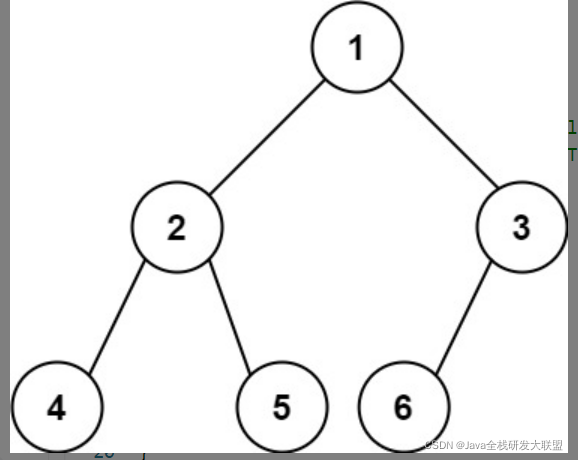题目描述
示例:

输入:root = [1,2,3,4,5,6]
输出:6
解法一:递归
凡是看到这种求二叉树的节点个数的问题,首先想到能不能用递归,然后如果能用递归的话,我们找出递归的逻辑。比如本题:
先确定单层循环逻辑: 先求它的左子树的节点数量,再求它的右子树的节点数量,最后取总和再加一 (加1是因为算上当前中间节点)就是目前节点为根节点的节点数量。
int leftnum=_countNodes(root->left);
int rightnum=_countNodes(root->right);
int treenum=leftnum+rightnum+1;
return treenum;
然后我们要知道递归的终止条件,对于本题而言,终止的情况就是
if(root==nullptr)
{
return 0;
}
所以很容易就能写出本题的答案代码
class Solution {
public:
int countNodes(TreeNode* root) {
if(root==nullptr)
{
return 0;
}
int left=countNodes(root->left);
int right=countNodes(root->right);
return left+right+1;
}
};
时间复杂度:O(n) 空间复杂度:O(log n)
解法二:迭代,层序遍历
因为本题的树形结构比较特殊,是完全二叉树,所以我们可以想到通过层序遍历来解决,从树的根节点开始,一层一层的往下遍历,遍历到最后一层就可以数完所有的节点个数
代码如下: (注:层序遍历的实现方式一般使用queue队列来实现)
class Solution {
public:
int countNodes(TreeNode* root) {
if(root==nullptr)
{
return 0;
}
queue<TreeNode*> q;
q.push(root);
int result=0;
while(!q.empty())
{
int size=q.size();
for(int i=0;i<size;i++)
{
TreeNode* node=q.front();
q.pop();
result++;
if(node->left) q.push(node->left);
if(node->right) q.push(node->right);
}
}
return result;
}
};
时间复杂度:O(n) 空间复杂度:O(n)
如果本题要我们计算“满二叉树”的节点个数,那就更简单。
因为满二叉树的节点个数很容易通过树的高度来计算。满二叉树的节点个数=
(
2
n
?
1
)
(2^n-1)
(2n?1)
代码也很好写:
int countNodes(TreeNode* root) {
int h = 0;
// 计算树的高度
while (root != null) {
root = root.left;
h++;
}
// 节点总数就是 2^h - 1
return (int)Math.pow(2, h) - 1;
}
